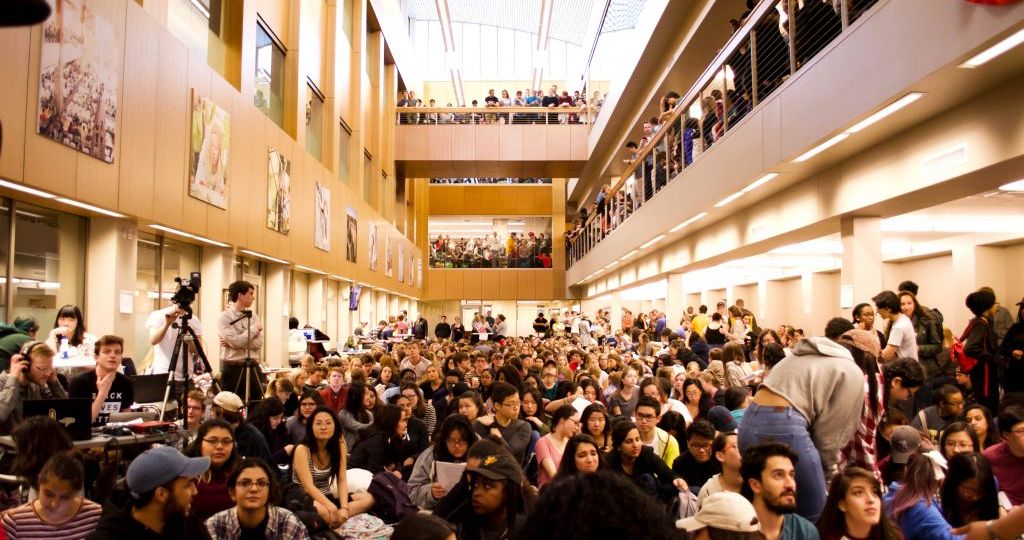
The Cultural Union for Black Expression (CUBE) challenged Friday’s “7 Feet for 7 Shots” march for its performative nature. Their charge against St. Olaf’s hesitance to institute meaningful change needs to be heard. St. Olaf must enact change which radically alters the core of the institution. Such anti-racist work begins by listening to the existing testimony of its students, alumni and faculty.
In their speeches on Friday, Joshua Wyatt ’21 and Brianne Smith ’23 leveraged a long-standing critique against President David Anderson ’74 and Vice President for Equity and Inclusion Bruce King—St. Olaf has consistently failed to establish anti-racist change on behalf of its BIPOC students.
Alongside email silence and consistent institutional failures, Anderson and King offered empty remarks at the march. An event planned by students as a way to speak directly to the College’s administration turned into an event where Anderson and King called for “celebration.”
In his speech on Friday, Anderson shared a story of how his views on race were altered by the birth of his biracial grandchildren. At a time where tangible action is essential for substantive change, Anderson offered a personal anecdote.
By focusing his speech on his biracial grandchildren, Anderson perpetuates the misconception that connections with any BIPOC person can expunge white folk of being racist; real anti-racism requires active participation in dismantling the College’s racist systems.
The core of non-performative action is anti-racism. There is a stark contrast between the work of an anti-racist institution and the work of a simply non-racist institution. Where non-racism points out its acceptance of a diversity of voices, anti-racism works to ensure these voices are appreciated, uplifted and respected.
Anti-racism starts as a radical shift from within, and the editorial board believes our administrators are not making the required purposeful changes. Until St. Olaf addresses the systemic racism affecting our campus, the school will continue to capitalize on universities’ short institutional memory to request student input and fail to do anything about it.
Instead, the President’s Leadership Team offers a solidarity statement without action to back up their words. They give students and faculty months of radio silence as Black people are killed in the streets by the police hired to protect them. Anti-racism involves critical self-reflection, recognizing and acting on the impact that one’s privilege has on others and identifying racism in institutional systems—the policies, procedures and practices. This needs to be an ongoing process rather than a checkbox on a to-do list.
As far as the actions St. Olaf has taken to create a supportive environment for students and faculty of color, the College’s desire to appear inclusive outweighs its actual impact.
Following the murder of George Floyd, St. Olaf created the George Floyd Fellowship for Social Change, an initiative that commits $100,000 to support the advancement of Black students. The Fellowship was interrogated by the Marginalized and Diverse Faculty of Color Anti-Racism Coalition (MAD FACS), a group working to dismantle the College’s culture of institutional racism. They point out that the “symbolically generous” $100,000 amounts to only .04 percent of the $252,000,000 raised during the “All in for the Hill” campaign.
The evasive language of our president and the formation of a performative fellowship represents St. Olaf’s deficient attempts at anti-racism. Five Black women faculty and staff, including Former Associate Professor of Theater Michelle Gibbs, and Former Associate of Social Work and Family Studies Lisa Moore leaving St. Olaf last school year further evidence the College’s failure.
In the “Commitment to Anti-Racism” delivered July 8, 2020, President Anderson presented five steps focused on “identifying where systemic change is needed.” Here, St. Olaf claims to invite student and faculty input despite consistently ignoring years of testimony and most recently stripping demands from the “7 Feet for 7 Shots” march.
St. Olaf, hear the statements from your students regarding Friday’s event. Hear the 17 demands still unmet from the 2017 protests. Hear how your own words—and your silence—perpetuate whiteness and anti-Blackness at an institutional level and how it leaves your faculty and students alienated in your “welcoming community.”
To undertake anti-racism work, St. Olaf College must stop standing against racism and start pushing. True anti-racist action requires listening to the existing evidence presented by faculty, alumni and students and enacting radical, long-demanded change.
The editorial board is composed of the Opinions Editors whose shared views are informed by journalistic research, dialogue and individual perspectives. The editorial board stands apart from the newsroom and does not represent The Olaf Messenger as a whole.
















